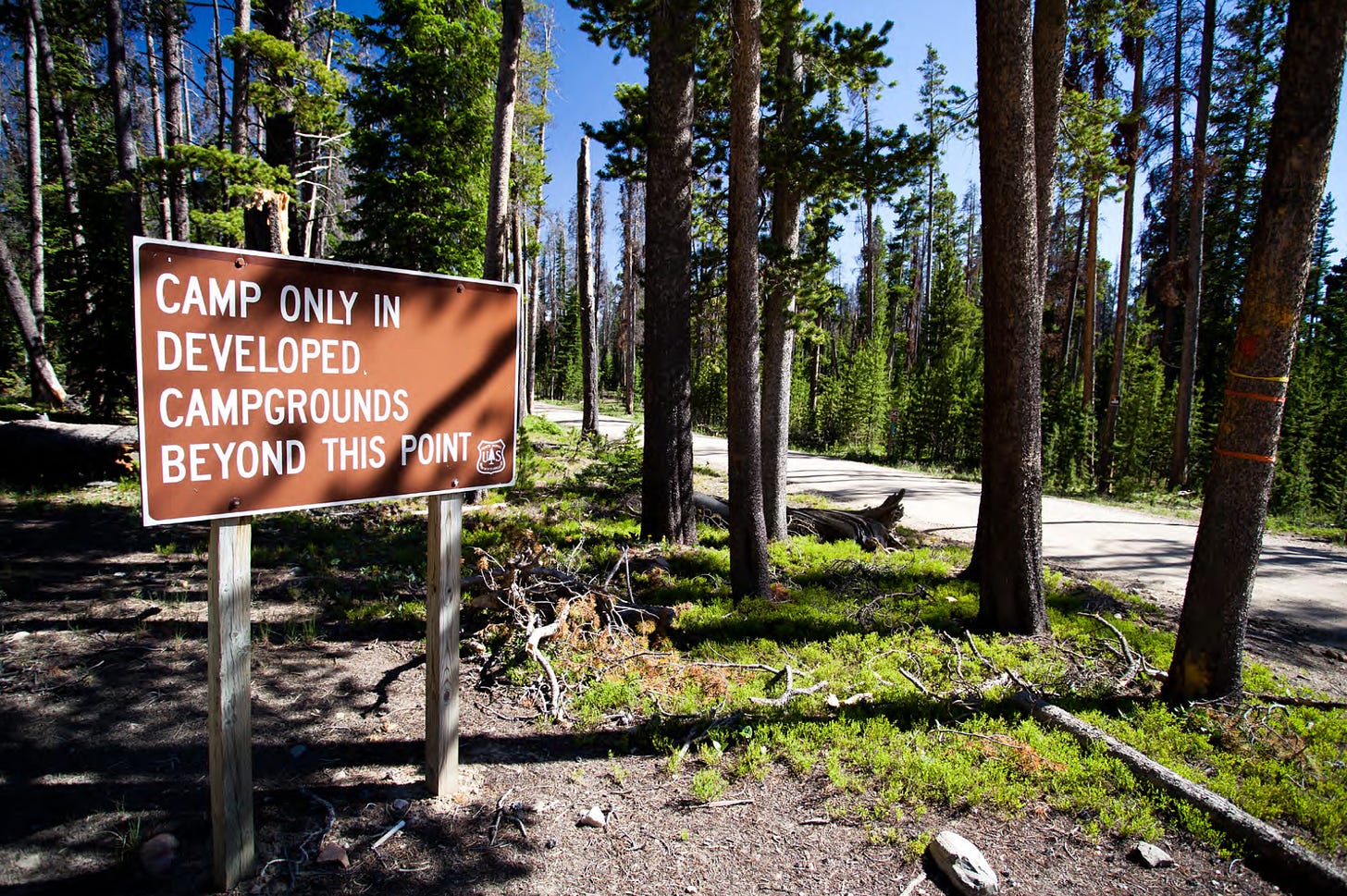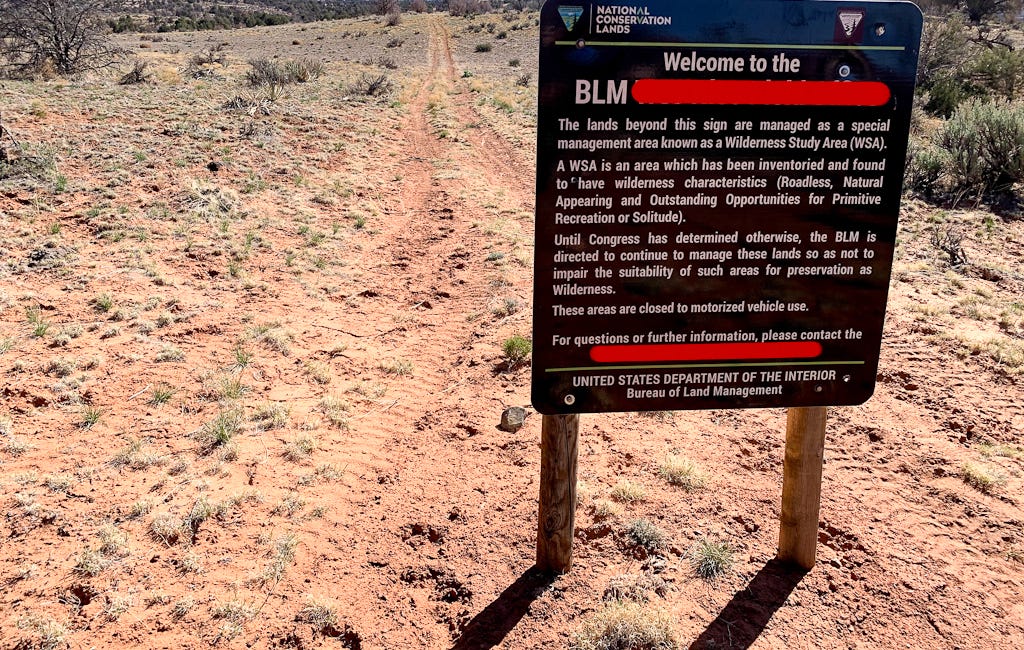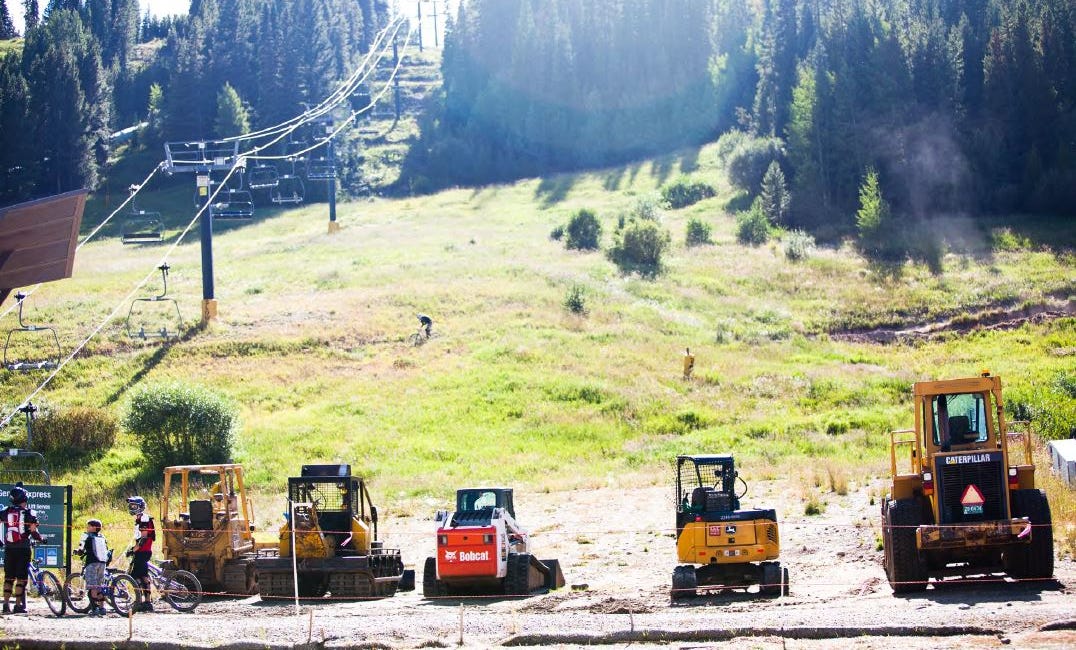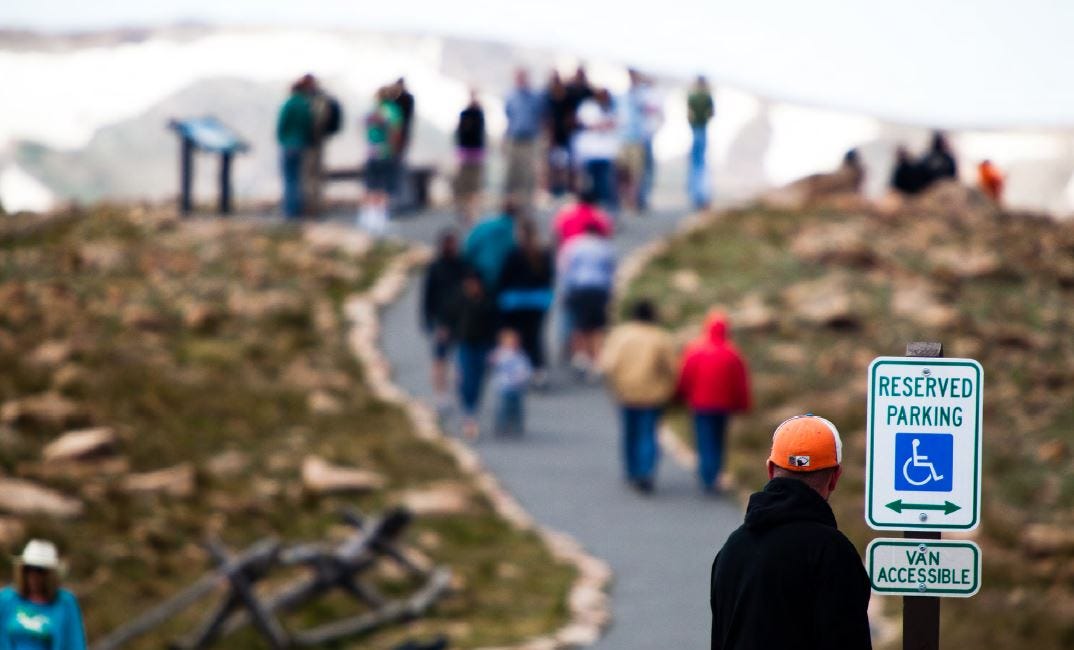Smoothing the West's wildland roads to make way for the New West
The American West's famous image of being wild and untamed is disappearing quickly and quietly to make way for a new and insidious form of mining.
The American West had a wild character until recently. Manifest Destiny gave way to all out Manifest Destruction via exposure of the West to the mainstream public thanks to social media and the use of imagery of Western lands to sell outdoor gear and act as a novel muslin backdrop for selfies1. The result is a change in the cultural mind of America where the land became an opportunity for the curation of novel identities that could be broadcast via social media, which suddenly led “flyover country” to become “destination country.”

But the West had a problem — its terrain was far too unpredictable and required far too much skill and risk to navigate for the common urban tourist who wanted to see the sights, take pictures, and have a good, easy time, without risking life and limb.
In the recent history of the West, we know that there was a push for the eastern U.S. to go West. That was known in the 1800s as Manifest Destiny. As in, it was to be the destiny of America to expand westward, despite the clear signs that the environment was volatile, there wasn’t enough water to sustain populations, and the terrain was steep, sharp, and generally opposite what’s needed for human habitation.
In the late 1800s and early 1900s, Colorado had wealthy aristocrat-types that were known as, “boosters.” Boosters were promoters of the State to help drive population growth, business growth, and to influence train lines and other vital infrastructure to come and center in Denver. Boosterism led to Denver being the Capitol, and led to train lines that made more sense to veer north or south around the Rockies to come to Denver instead.
Fast forward to today, and boosterism is live and well — we just call it marketing, visitation bureaus, and social media hashtags that flag what you’re seeing for all your social media “friends” back east. The boosters of a century ago are multiplied in power by orders of magnitude today, marketing states of the West to anyone, anywhere, and maybe even virally to strangers they’ve never met.
The explosive interest in the lands of the West is on an exponential growth curve, with a sharp uptick since the advent of social media.
The West’s Rough Roads
Prior to the light-speed increase in getting the word out about what you saw on your vacation via the internet, the only way to find things of interest in the West before modern wireless technology was with a map, intensive outdoor skills, some equipment, and some risk. Even in the past when people were heartier, not many were interested in finding a map library just to look at some maps of some unknown places, then throw the dart and go there. Only to arrive and find that their Buick Roadmaster wasn’t capable of getting through the rough unmaintained paths into places that are all named with references to hell or the devil.
Until the internet and social media, places like Moab, Utah, were only knowable to those nearby - or those forced there for some other purpose, like mining. Or to those who were truly adventurous and went just to see what’s out there.

The roads of the West were rough. In the recent past, they were horse-grade paths intended only to get industrial-grade vehicles in or out of a place, and they were entirely meant for extracting raw materials from that place.
It’s why on the really old routes in the West, you can find many very old and abandoned cars, and sometimes even wagons or old steam-powered mining equipment. And all of the miscellaneous vehicles and parts were from the time when roads were being made across the West for mining and resource exploration.
These old routes weren’t built for comfort. They weren’t built for modern city cars. They were just built to allow miners and their tools to get in and out of a place.
Times have clearly changed, and so has the West.
Smooth roads for a new form of mining
My entire life away from work and school has been spent outdoors. And I don’t mean spent outdoors like the modern dandies do it. I mean, with maps, off the grid, away from people, camping out of a truck on an abandoned road, then loading a backpack and heading out beyond where any vehicle can go. The point is always to go see what’s out there, and do it by adapting myself / ourselves to the place we’re going - rather than forcing it to adapt to us by only utilizing sanitized tourist infrastructure.
If I had a vehicle breakdown in most of the places I go, a recovery would either be near impossible to find, scary expensive, or just not possible. And I do this because I’m wired to see what’s out there — not just following the herd to the National Park Service (NPS) museum-signed viewpoints.
But, again, times change.
Over the last 20 years or so, the roads of the West have gotten objectively smoother. The scary areas get closed down, or at best, they get engineered to not be scary anymore. The time the federal, state, and county governments take to smooth out the roads is clearly now a resourced priority. So much so, it’s almost like there’s money in it …

The roads of Utah have gone from wildland-grade mining road to buttery smooth and graded, year around. Utah is so crazy about grading roads now, most of the obstacles that once gave the roads their wild character have now been removed. I’ve frequently wondered why they do this - and until recently, really didn’t know - I only suspected a variety of reasons.
Well, it turns out, I was mostly on the right track. Roads throughout the West get their regular Brazilian wax job now, thanks to the tourist dollars they bring. Yep, that’s right — the graded roads make things nice and smooth for tourists, mining outfits, and probably ranchers, too.
The rate roads are being graded in the West is alarming. Since I spend all of my free time roaming open lands, I have a pretty strong beat on this. Most of my maps have fallen out of date extremely rapidly. Most of the roads that were once unmaintained are now bladed smoother than I-70 through Vail, Colorado.
I don’t know how the agencies that oversee these lands are sterilizing the place so quickly and effectively2. Closely dashed lines on maps usually mean unmaintained and high-clearance 4WD only, but these roads are getting smoothed out faster than a cake getting frosted by a seasoned professional cake maker.
The great irony of smooth roads in wildland areas
There’s a very clear connection between the smoothing out of wildland roads throughout the West and the rise of tourism and migration to the West3.
The people moving and touristing here are looking to see and do what they saw their friend or some influencer do on social media. The hordes that have shown up and demolished Moab, UT in the last 20 years are seeking the imagery they saw there. They want to be part of it. They want their picture taken on the edge of that cliff, near that ruin left by the ancient ones, and they want it the same way they got their picture taken with Mickey Mouse4. Easily. Without risk. Without a lifetime of developing skills to navigate the non-human jungle.

The tourist isn’t just one cultural species — it’s many. Some tourists spent 10 years modding out a truck to be an extreme rock crawler. They want their picture taken in Mickey’s Bathtub in Moab. Other tourists go for a run every morning so they can backpack from the trailhead to that one arch they saw on Instagram5. Others think that if you go to Moab, the backdrops are all just there in town, so they book a hotel that doesn’t look sketchy, and wander around looking for those images so they can have one too. Some want to be pampered in some exotic-looking location, and the thought of stepping outside the boundaries of the spa / hotel isn’t on the table.
The great irony is that what most people think they’re coming West for is wild places - and wild images - and they want to be seen in that. They see themselves in it, as if they’re doing what even the experts are doing. Same place, must be same experience.
Of course that’s not how they see themselves thinking about it, but that’s what’s happening. And you can see their thoughts, wants, and actions manifesting on the land, like some kind of mystical destiny.
What people create demand for manifests in the way the land is managed.
Tourists and transplants create demand for easy to travel spaces. They complain to the rangers and land bureaus when roads are too bad for their CUV to travel on. They don’t come back and leave tax revenue and tourist money when they don’t get to accomplish what they came for. When they leave money, they increase supply of these services, and when they stop coming, they leave a crater in the local economy. And those tourist dollars feel oOoh so good …
And so, the land is adapted to fit them, their lifestyles, and expectations of experience.

The way a person thinks about wild spaces, about their place in a landscape, and whether they think of places as commodities or as having inherent value, fundamentally shapes how these places either get managed or not.
I’ve noticed that most tourist-minded individuals who go for the t-shirt and sticker shops seem to really like easy and catered. They don’t so much like rough roads, having to read maps, carry tools and parts to repair their vehicles, and definitely don’t understand anything regarding “survival.” They want a smooth road that they can drive their rental car on. They want a hotel within an hour’s drive of the monument or scenic viewpoint. And if they’re the intrepid variety of tourist who might rough it in a tent or RV, they definitely want to be able to get to a numbered camp site that they reserved in advance.
That kind of tourist leaves money behind. They leave money with the federal government, state and county governments, and they leave even more money with local tourist shops and restaurants. They create more demand and more revenue for these services.
The dollar is demand for the domestication of wild places
In my little lifelong anecdotal case study of wildland roads and areas throughout the West, the sharp uptick in change over the last 10 years (especially) has been motivated by imagery getting out about what’s here, and people being inspired to come get a piece of it.
The piece they want is of themselves in that place - with an epic backdrop, and they’re doing something they perceive to be epic, too. They want it however they can get it, but preferably by methods and established pathways that they’re used to. Rental cars, directions from a ranger, a signed path, other people around, and smooth roads that their rental car or personal CUV can get to. Danger removed.
They think they’re coming for the same thing they saw on social media — somebody camped out on a cliff edge, or at a high mountain lake, either out of a backpack or some nondescript vehicle. But they aren’t really coming for what they think they’re coming for.
Most of the tourists today are creating demand for infrastructure. For services. For planned recreation. All of those things are entirely contrary to wild - they are features of domestic spaces where wildness is controlled for the entertainment of unfamiliar and unacculturated audiences. Every dollar they spend is a vote for more domestic services, more planned recreational spaces, and more of those scary roads that aren’t maintained by a road grader to be smoothed out.

Yet they all believe they’re here for these wild places.
I can tell you from my lifetime of my family adapting ourselves to the place and carrying that tradition, that none of what’s happening in the West is out of interest in wildlands and wild places. It’s all entirely urban-minded, image-driven, domestication of the landscape by those who need the land to adapt to them, rather than adapting themselves to the land6.

Sure, we all like to drive in to a beautiful place on a smooth road, and know we’re going to get a camp site that we reserved online days or months before. But that’s not wild places. That’s only possible in domesticated places. And what we’re doing by smoothing out all of the roads and trails in the West for the new invasive tourist is to urbanize and domesticate these once wild places.
The people we’re domesticating the West for aren’t worth the damage that’s being done to cater to them. Tourists are consumers. They’re inherently outsiders. They project their idea of what “good” is on every place they go, and they vote with their money what they liked and didn’t like. For those of us who liked the West as a wild place and adapted ourselves to it, there is no greater example of colonialism, runaway capitalism, and cognitive dissonance, than the tourists and transplants that are transforming the West today.
The Fleeting West is written by a deeply rooted Westerner with a generational tradition of adapting ourselves to the place, rather than the place to ourselves.
Footnotes and Citations
This comment ties back to the use of the West to sell outdoor gear, connection to nature, and likes on social media …
Why I'm boycotting REI - and any other organization selling out the West for profit.
What could an outdoor gear retailer possibly have done to deserve being boycotted? It’s an interesting story, and one that I have repeatedly accidentally helped to fund. And it’s not just me – it’s my whole family. My dad has such a small REI member number, the cashiers often ask him if the number is real – it’s that small because he got it so long ago.…
Rampant road grading is really only the tip of the iceberg. In the following post, I wrote about the parallel change sweeping the West, which is the outright closure of these roads.
Wildland Road Closures Spreading Across the American West
There are a few kinds of people in this world – those who are centered in the human domain, those who do best at the perimeter of the human domain, and those who are centered outside the human domestic spaces of cities and fencelines. Most of my life has been spent mentally elsewhere, outside of the urbanized spaces where people scrape the land and rema…
For further differentiation, know that there’s a very large and largely invisible gap between; wilderness, Wilderness, and wildness … I differentiate that here:
Let’s talk about wildness in the West
My significant other and I were watching some low-thought TV the other night on NetFlix and happened on this show about vacation properties – one of which was in my neck of the woods. It rented for $12,000 per night and one of the hosts noted it was in the “Blah Blah Wilderness” (omitting the name to prevent over-loving of the place.) Yes, a $12,000 per…
What I’m talking about in this paragraph are “posers” — more about that here:
What’s a poser, and why is the West full of them?
Caution: The following post is laced with heavy sarcasm and some downright mean depictions of New Westerners (charlatans) … fans of selfies, inauthentic identities, social media fakery, and online trip reports may be offended by the contents of this post.
While I am also a lifetime and dedicated hiker, I have noticed that the flavor of tourist who hikes, often views themselves as being one with “nature” as soon as the car turns off. That’s a big topic, which I address in this post:
Hiking is a petroleum sport.
Sometime around the 2010’s, John Muir’s quote made it into mainstream culture – onto T-shirts, hats, tattoos, and even tire covers for rear-mounted spare tires on 4x4s. You know the one, “The mountains are calling, and I must go…” The quote imprinted itself in the minds of urbanites all across the country, from those living near the shores of New Jersey…
It seems that adventure truly is the modern fashion accessory … read more here:
Adventure - it’s the modern fashion accessory
Rewind a few years, we had the COVID-19 pandemic. You suddenly couldn’t touch a ten year old Toyota Tacoma in Colorado for under the price of new, and new ones started selling like toilet paper off a Walmart shelf. Rewind a few years prior, and brands like REI, Backcountry, Patagonia, and others made the outdoor look the new in-style fashion. These bran…










